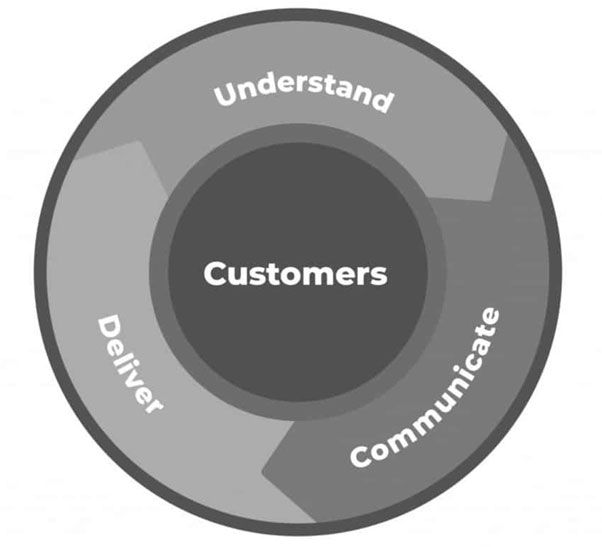The SaaS industry’s rapid development entails changes in customers’ behavior. People prefer trying a product to talking with a salesperson or visiting long demos. In other words, the sales-led strategy common for the high-touch customer engagement model becomes a bit outdated giving way to the product-led growth approach.
Why does a sales-led strategy die out?
Firstly, relying on your sales team, you depend on each sales rep’s ability to present your product most effectively and make customers eager to buy. You’re keeping the product untouchable until the moment people pay for it. A few years ago, this approach worked, but now customers became much more demanding, having many alternatives to go with. People want to be sure your product is exactly what they need before typing in a credit card number.
Secondly, a sales-led approach makes your customer acquisition cost extremely high. The maintenance of a great sales team is expensive. A high-touch model implies quite a long sales cycle that naturally increases CAC and, to ensure profitability, demands customer LTV being high to offset the customer acquisition costs. Seeking for a solution to cover high CAC, companies try upgrading customers to premium. The truth is that premium price is not an indicator of a higher product value for customers. It’s a necessary measure for SaaS businesses to cover increasing acquisition costs and remain profitable.
In the face of growing competition, considering how to reduce their CAC, SaaS companies started shifting to conceptually different acquisition strategies. Not sells a product, but the product sells itself. Product-led growth allows people to try the product and buy it only if they feel that it’s a match.
Slack, Evernote, Dropbox are among those pioneers who employed product-led growth and benefited from this approach. Using freemium and free trial pricing strategies, these companies attracted customers and made them discover product value through direct interaction.
What does it mean to be a product-led company?
The main principle the product-led company follows is making a product value the priority. It’s impossible to grow if your product doesn’t have real value for the customers, and they can easily replace it with competitors’ offerings. The trick is your product should be sticky. If clients can’t help using the product because it satisfies their needs and relieves their pains, your growth is a matter of time and effort you put into your product improvement.
Product-led growth implies that all departments in your company influence the product.

The marketing team thinks about how to demonstrate product values better and generate demand. The sales team considers how to use the product to qualify leads. The customer success team focuses on answering how to create a product that will outperform customer expectations and help them become successful.
Main steps to follow for a product-led strategy development

Here are the essential steps you need to take to build a strong basement for your product-led growth.
Make clear your value proposition.
It often happens that SaaS companies concentrating on creating a feature-rich product don’t clearly understand why customers buy it. However, people don’t purchase just a “tool” – they buy a solution to their problem.
Thus, it’s crucial to define:
- what job customers want to be done with your product’s help
- what emotions they want to feel when using your product
- how they want to be perceived by other people
The deeper you penetrate your customers’ minds, the better you can understand what your customers want, the easier it will be to communicate to them your product value.
Communicate your product value
As a SaaS company, we can convey our product value through comprehensive value propositions tailored to each buyer’s persona’s needs. Value-based pricing is the best approach to pack your offering and demonstrate it to potential customers on a pricing page. Whereas sales-led companies preferred to hide their pricing, pushing a lead to contact sales to get a quote, product-led businesses openly show up pricing for most starter plans removing unnecessary frictions.
In a product-led SaaS company, revenue and customer acquisitions are closely connected. In a sales-led company, you can bet on selling a large contract to cover your expenses and generate income. A poor product is why the revenue is unstable in a product-led company, and customer churn is high.
Keep your promises
The biggest problem of many SaaS companies is overpromising and under-delivering. When there is a huge difference between what your sales and marketing pitch to your leads and what your customers actually experience, the trust in your company drastically goes down. Product-led businesses give people the possibility to “try before buy.” Because customers know what they will be paying for, the percentage of churned users for product-led companies is lower than for the sales-led ones.
Why does product-led growth is the only way to go?
In theory, product-led growth sounds inspiring and promising. However, when it comes to implementing this strategy, a company may face lots of challenges. Difficulty defining the target audience, inability to speak customers’ language, and poor onboardings complicate product-led strategy realization.
Nevertheless, product-led growth seems to be the only way for those SaaS companies determined to survive in a challenging business environment of a highly competitive market.
Here are the main threats SaaS companies currently face:
Customer acquisition costs are getting higher.
Profitwell states that CACs have grown almost by 60% in the last five years. Along with the CAC increase, the customers’ willingness to pay decreased by more than 30%. The high customer churn deteriorates the situation, blatantly hinting at huge business losses.
People tend to self-education.
Buyers want to try a product before purchasing it, and they expect to do this in an easy and hassle-free manner. That’s why more and more companies are currently adopting freemium or free trials pricing models, which help customers quickly decide if the product is a good fit for them.
Product experience decides everything.
There is no need for customers to talk to salespeople or watch extended demos if they can test and try a company’s product and decide on the spot whether to buy it or not. If the product sucks, people won’t give it a second chance.
A final word
Even though product-led growth is definitely an increasing trend, there is still room for an old good sales-led approach. It can work if a company offers some niche and exclusive product operating on a narrow market where each client is valuable. In all other cases, if we talk about SaaS, product-led growth becomes the only way to survive for most SaaS companies.

Namaste UI collaborates closely with clients to develop tailored guest posting strategies that align with their unique goals and target audiences. Their commitment to delivering high-quality, niche-specific content ensures that each guest post not only meets but exceeds the expectations of both clients and the hosting platforms. Connect with us on social media for the latest updates on guest posting trends, outreach strategies, and digital marketing tips. For any types of guest posting services, contact us on info[at]namasteui.com.

